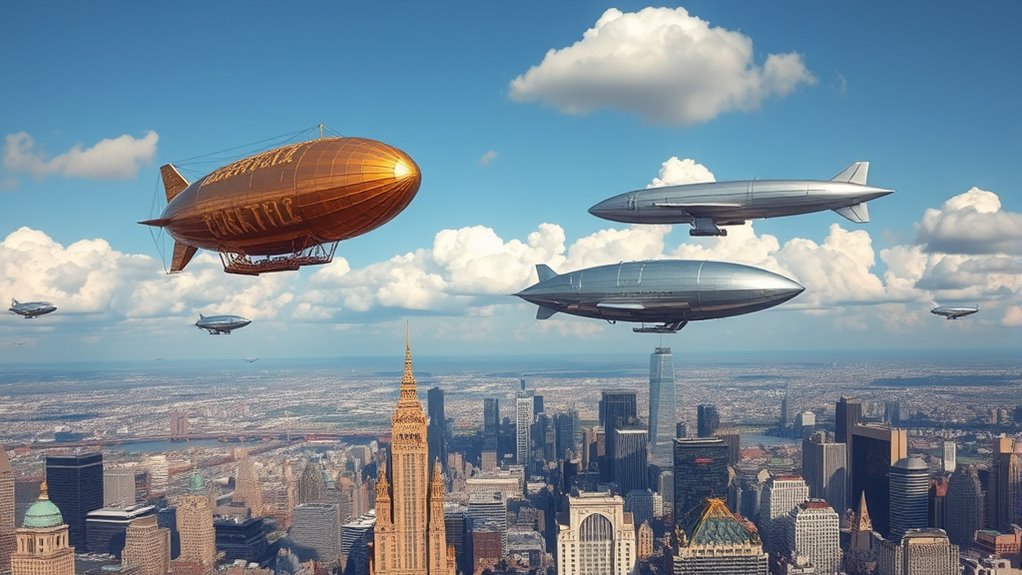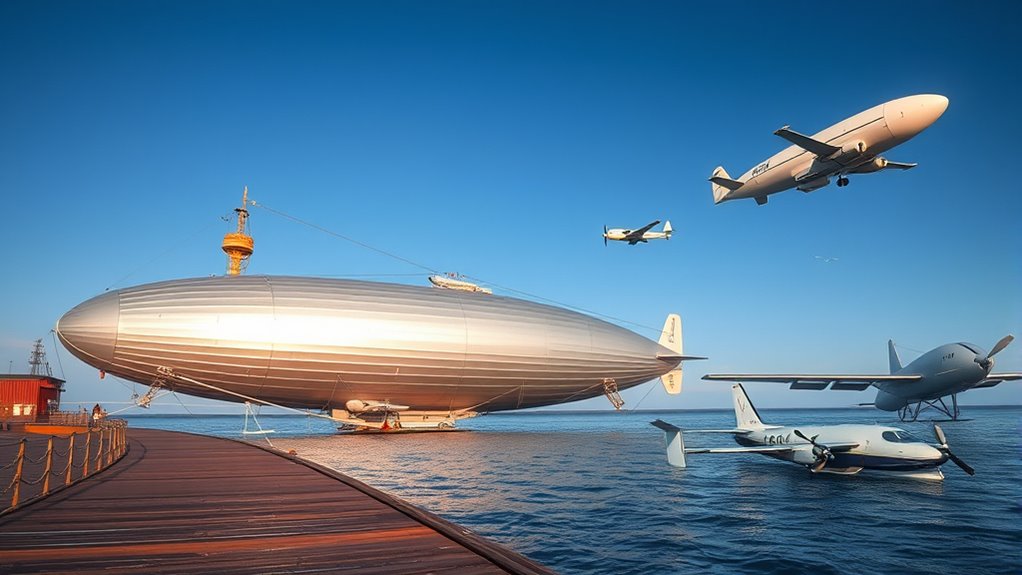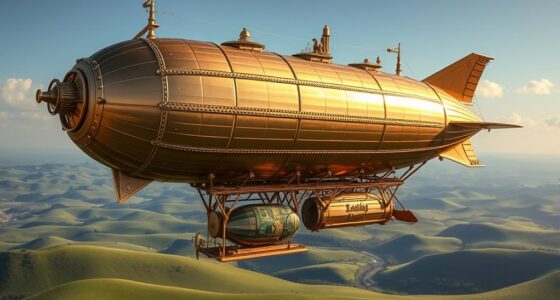Airships began as Victorian symbols of innovation, representing human ingenuity and the hope for faster travel, using hydrogen and helium gases. Today, they’ve evolved into practical tools thanks to advanced materials, safer gases, and modern tech like GPS and composites. They now serve niche markets such as eco-friendly cargo, surveillance, and tourism, blending historic dreams with today’s cutting-edge engineering. To discover how these flying marvels have transformed over time, keep exploring their fascinating journey.
Key Takeaways
- Victorian airships symbolized innovation and ambition, sparking global interest in lighter-than-air flight.
- Modern advancements use safer helium, lightweight composites, and digital systems to improve safety and efficiency.
- Victorian designs prioritized long-distance travel and grandeur, while contemporary models focus on sustainability and niche applications.
- Early safety concerns with hydrogen have been addressed through material improvements and technological innovations.
- Today’s airships embody a blend of historical dreams, engineering progress, and practical uses like eco-friendly cargo and surveillance.

Have you ever wondered how airships revolutionized transportation and exploration? During the Victorian era, airships represented the pinnacle of human ingenuity and ambition. They were seen as the future of travel, promising to connect distant parts of the world quickly and efficiently. These vessels are prime examples of historical innovations, showcasing the technological strides made during that period. Designers experimented with lighter-than-air gases like hydrogen and helium, pioneering the use of large envelopes filled with these gases to lift heavy payloads. The fascination with airships sparked worldwide interest, leading to significant developments in aeronautics. Pioneering efforts by inventors such as Ferdinand von Zeppelin laid the foundation for modern airship design, emphasizing stability, safety, and long-distance capability. These innovations weren’t just about transportation—they symbolized progress, human curiosity, and the desire to conquer the skies. Additionally, understanding the spiritual significance of innovations like airships can offer deeper insight into their cultural symbolism and the collective aspirations they embodied.
Fast forward to today, and the reality of airships has shifted from Victorian dreams to modern advancements. While they no longer dominate commercial travel, modern engineers see potential for airships as eco-friendly alternatives for cargo delivery, surveillance, and tourism. Advances in materials science and aerodynamics have made contemporary airships safer, more reliable, and more efficient. Modern airships are often constructed with lightweight composites and helium, which is non-flammable and much safer than hydrogen. These technological improvements address many safety concerns that plagued early models, making airships more viable for practical applications. In recent years, companies have experimented with hybrid designs that combine traditional buoyant lift with aerodynamic propulsion, increasing speed and maneuverability. Additionally, GPS navigation and digital control systems have transformed airship operation, allowing for precise handling and safer flights. These innovations exemplify how modern advancements build upon the foundation of historical innovations, turning early dreams into tangible, functional technology.
Despite their limited role in mainstream transportation today, airships continue to evolve, driven by innovation and environmental considerations. Unlike the romanticized Victorian visions of sky-bound ships traveling across continents, today’s airships serve niche markets where their unique strengths—low emissions, ability to hover, and capacity to access hard-to-reach areas—offer tangible benefits. The journey from Victorian aspirations to modern engineering exemplifies how aeronautics has progressed, blending historical innovation with cutting-edge technology. As you look up at the sky, it’s inspiring to think about how far airship technology has come, transforming from a symbol of Victorian dreams into a practical, sustainable tool for tomorrow’s world.
Frequently Asked Questions
How Did Victorian Airship Designs Influence Modern Aerospace Engineering?
Victorian innovation in airship design markedly influenced modern aerospace engineering by inspiring a focus on lightweight materials and streamlined shapes. You see this design evolution reflected today in the emphasis on aerodynamics and safety. Victorian pioneers experimented with rigid structures and buoyant gases, laying a foundation for contemporary aircraft. Their inventive spirit continues to shape modern aircraft, proving that early innovations can have lasting impacts on aerospace development.
What Are the Environmental Impacts of Current Airship Technologies?
You might wonder about the environmental impacts of current airship tech. Today’s airships have a lower carbon footprint compared to airplanes because they use less fuel and emit fewer greenhouse gases. Plus, they generate minimal noise pollution, making them more eco-friendly for urban and remote areas. This helps reduce environmental harm, supporting sustainable travel and cargo transport, and aligns with efforts to protect our planet.
How Do Safety Measures for Historical Airships Compare to Today’S Standards?
You’ll find that safety measures for historical airships were less advanced, often relying on rigid structures like wooden frames that offered limited protection. Today’s standards prioritize passenger safety with reinforced cabins, modern materials, and rigorous inspections. You can expect extensive safety protocols, such as emergency systems and real-time monitoring, which weren’t available in the Victorian era. These improvements markedly reduce risks and ensure a safer flying experience now.
What Role Do Airships Play in Contemporary Scientific Research?
You might find that airships play a essential role in contemporary scientific research through balloon experiments and atmospheric monitoring. They provide a stable platform for collecting data at various altitudes, helping scientists study weather patterns, climate change, and pollution. Unlike traditional aircraft, airships can hover for long periods, making them ideal for detailed observations and experiments. Their unique capabilities continue to advance our understanding of the environment and atmospheric phenomena.
Are There Future Innovations Planned for Commercial Airship Travel?
You might be excited to hear that future innovations for commercial airship travel aim to revive luxury travel and cargo transportation. Companies are exploring eco-friendly designs with advanced materials, making journeys smoother and more sustainable. You could soon enjoy scenic, comfortable flights, while airships efficiently move freight across difficult terrains. These innovations promise to blend nostalgia with modern technology, transforming how you experience travel and cargo logistics in the years ahead.
Conclusion
Just as a fragile kite dances against the wind, your dreams of airships soar between Victorian wonder and modern reality. You chase the horizon’s whisper, balancing hope and innovation like a tightrope walker. Though the sky’s vast canvas is dotted with progress, the spirit of exploration remains unbroken—an eternal flame guiding you through storms and stillness alike. Keep reaching upward, for the sky’s promise beckons, forever inviting you to chase the clouds of possibility.









